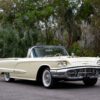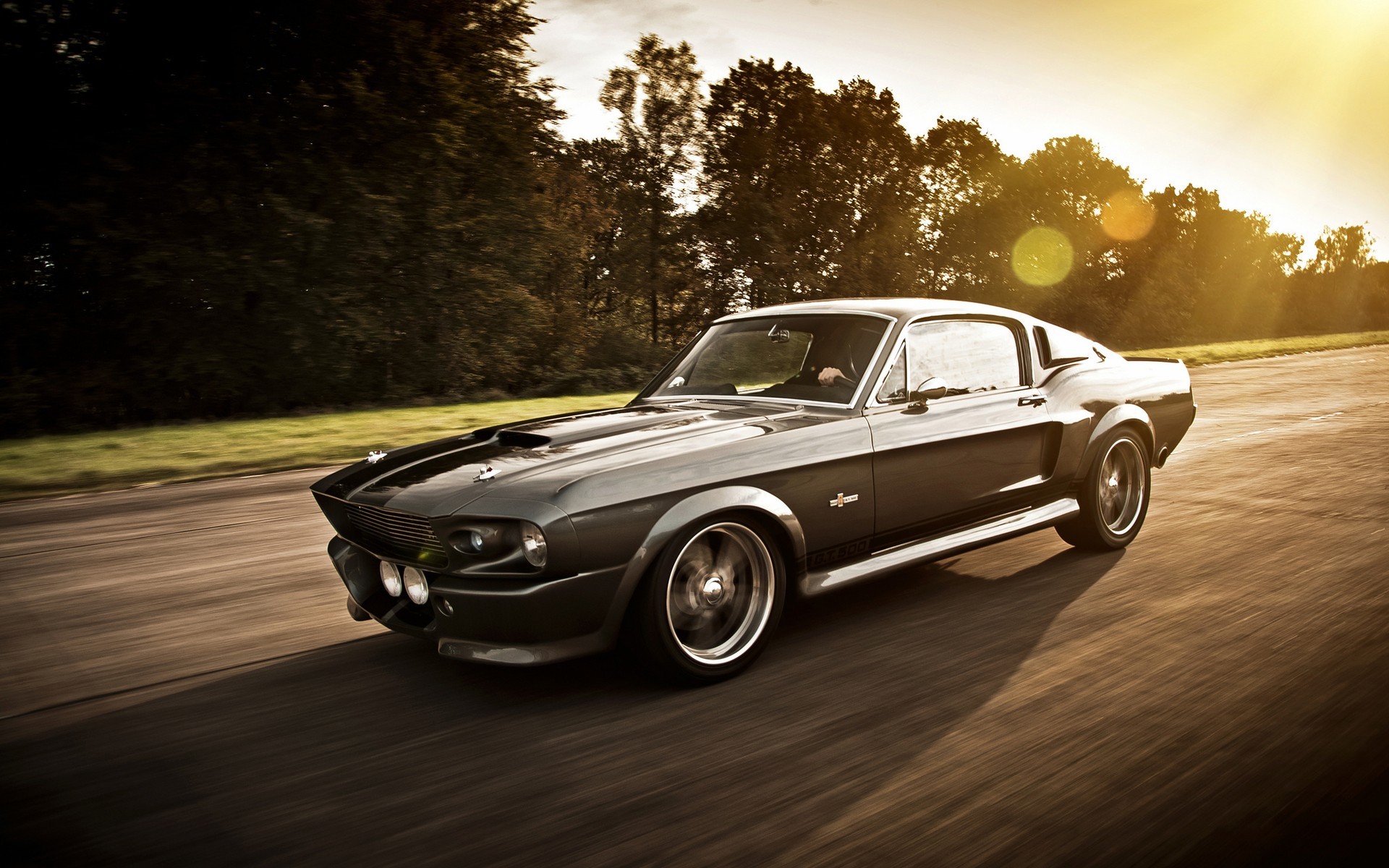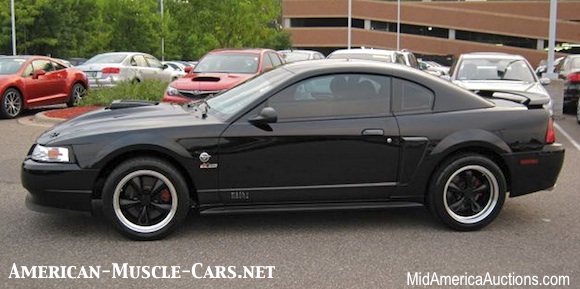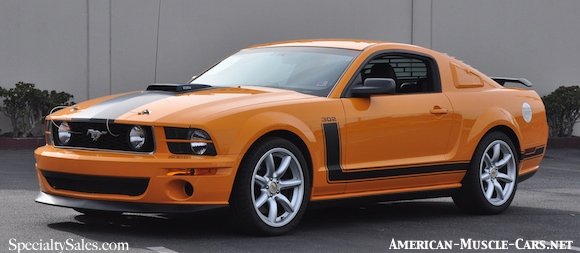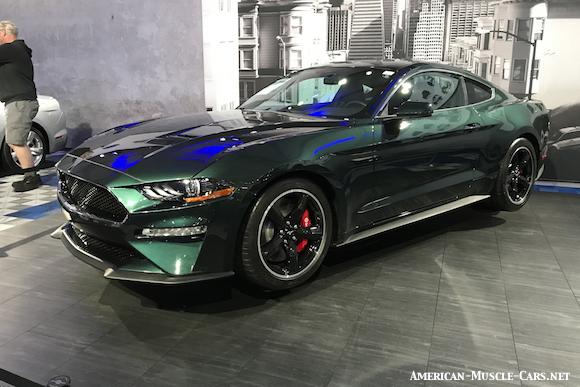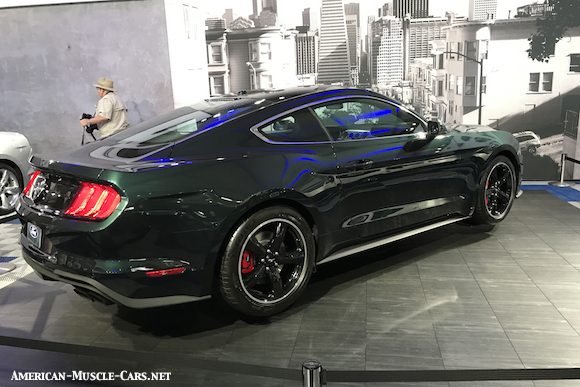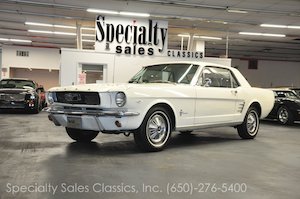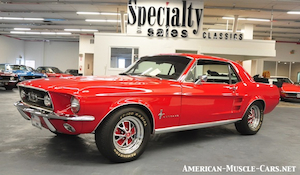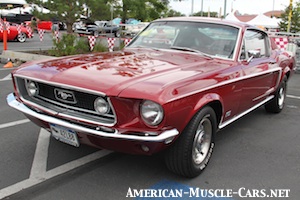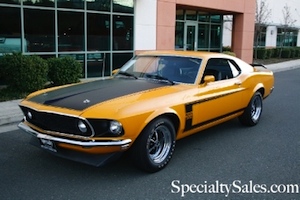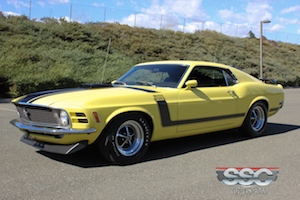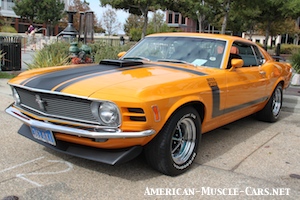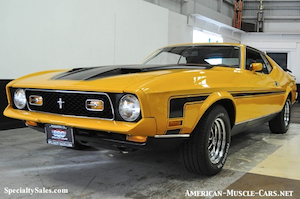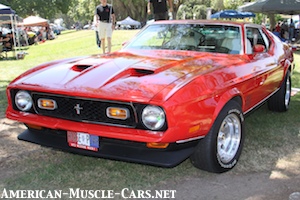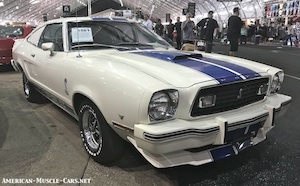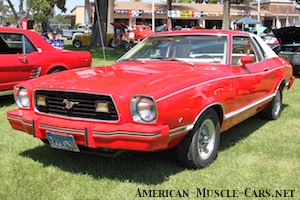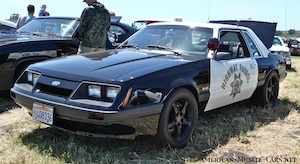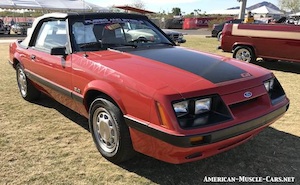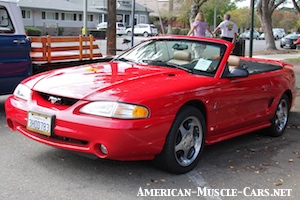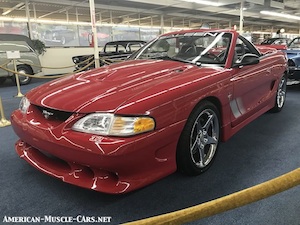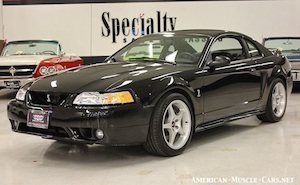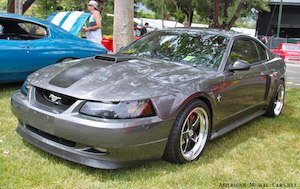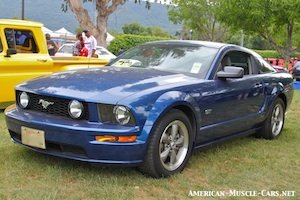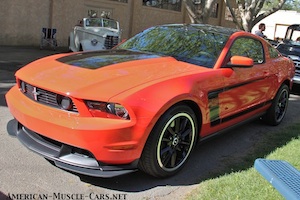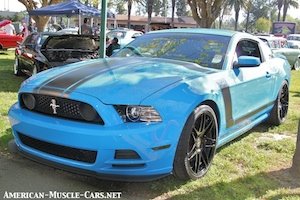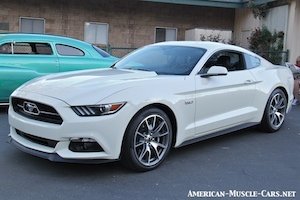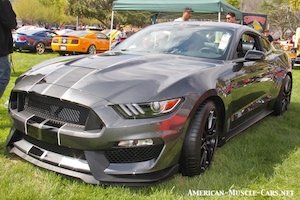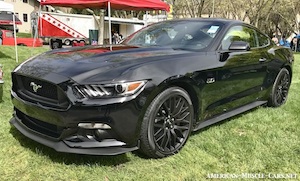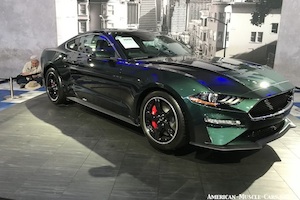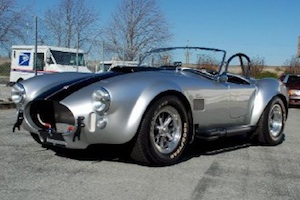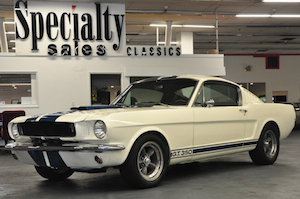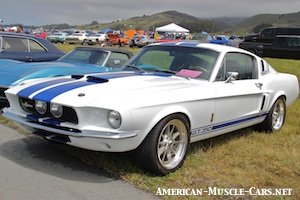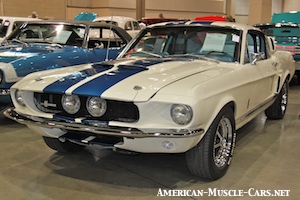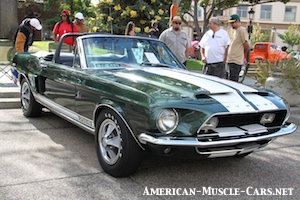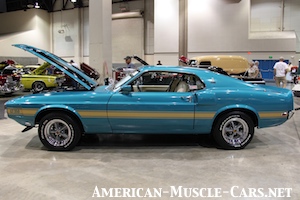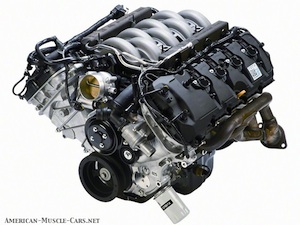Ford Mustang

ABOVE: 1970 Ford Mustang Boss 302.
FORD MUSTANG IS AN ICON
There are just a handful of cars in the 110+ year history of the automobile that truly stand out as true game-changers, the Ford Model T, the VW Bug, among others…and the Ford Mustang. Because when it came out in 1964 as an early ’65 model, it changed everything. The first car to truly designed from the ground up for the emerging “youth market”. Most youth-oriented cars in 1964 were really just hardtop versions of their mid-sized family cars, tarted up with special trim and a big engine. The Pontiac GTO for instance was just a fancied-up 2-door Tempest with a 389 V8 out of a full-sized car. But the Mustang was something completely different. Sure it was built on the plebeian Ford Falcon chassic, but no one seemed to care once they saw those sexy lines. It was like nothing before it. The Mustang had the style of a European sports car, with the reliability and low cost of a Ford. And if you ordered it right, there was plenty of high performance on tap.
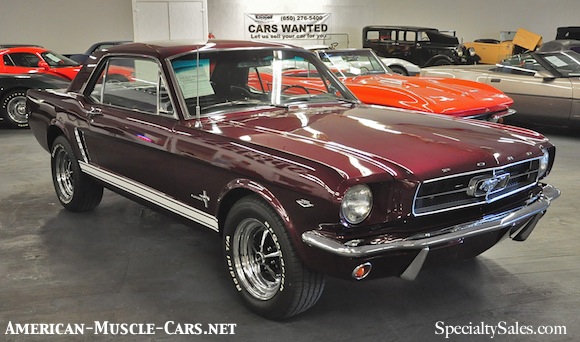
ABOVE: 1965 Mustang GT with Magnum 500 styled steel wheels.
IS IT A 1965 FORD MUSTANG OR A 1964-1/2?
There has always been some confusion about 1964-1/2 Mustangs versus 1965 Mustangs. In fact, technically speaking there are no actual 1964-1/2s. They were all titled and coded as 1965 models. However, they started producing them much earlier than normal in the traditional product cycle. Normally, a car maker starts building next year’s cars in August or September of this year. So, Ford should have started building 1965 Mustangs in August of 1964. But instead they started building them in March of 1964, and the first one was sold in April of ’64, well ahead of the normal release date of September, but also well after the normal start date for the 1964 model year. Hence the confusion. And there were many differences in the cars before August 1964 and those built after. For instance the base V8 in the early cars was a 260, where the later ‘65s had 289s. The early cars had generators where the later ones had alternators. The early cars had 2-speed blower motors, the later cars had 3-speeds. The list goes on. Over the years, it has become common and acceptable to call early-1965 Mustangs ’64-1/2s.
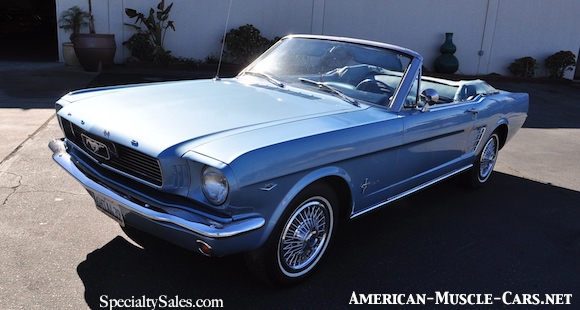
ABOVE: 1966 Mustang Convertible with wire wheel hubcaps.
NO COMPETITION FOR THE FORD MUSTANG
The ’Youth Market’, as it was called, was made up of Baby Boomers, the 95 million American babies born between 1946 and 1964, the oldest of whom were just now reaching car-buying age in the early 60s. And because of the affluence of their parents’ generation, they had the disposable income to buy a decent car. And each of the Detroit Big 3 had just the car for them. But Ford trumped them all by melding a sleek new body onto the Falcon’s bones, thereby saving millions in engineering, development and tooling costs. And the Falcon had already proven itself to be reliable, having been on the road since 1960. It was the perfect plan at the perfect time. The Mustang’s release on April 17, 1964 not only took the world by storm, it caught the rest of the industry flat-footed. No one had anything that could compete with it, and Ford enjoyed this windfall for nearly 3 years before GM finally fired off their response, the Chevrolet Camaro and the Pontiac Firebird, selling over 700,000 units the first year alone (albeit an unusually long year). By 1967 when the Camaro and Firebird came out, the Ford had already sold over 1.3 million Mustangs! Business was good, and the people were loving it. Everyone was crazy about the Mustang!
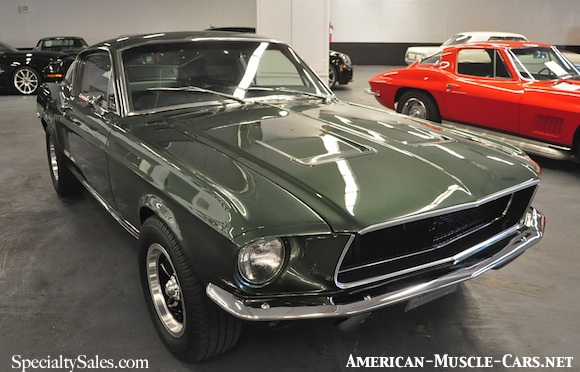
ABOVE: 1968 Mustang Fastback.
FORD MUSTANG LOADED UP WITH OPTIONS
Part of the secret to the Mustang’s success was the ability of the buyer to order it up just about any way they wanted it. From lowly 6 cylinders with 3-speed manuals, up through a series of small block V8s, high-performance V-8s, and soon Big Block V8s, 4-speeds, automatics, air conditioning, power options, appearance packages, and performance groups, you could really personalize your Mustang, all in 3 body styles.
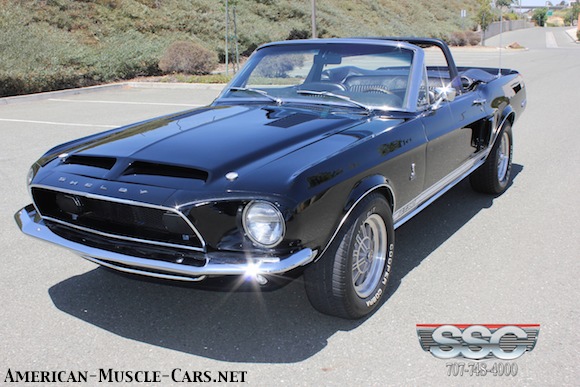
ABOVE: Carroll Shelby built some terrific Mustangs for Ford, the most famous of which being the GT350. By 1968, Ford had taken over production, and licensed the Shelby name, but the Shelby magic was somehow missing.
EVOLUTION OF THE FORD MUSTANG
Ford changed the body style every 2 model years from it’s launch in 1965 to the end of the Muscle Car Era in 1970. The next change in 1971 lasted 3 model years, when it was replaced by the dreaded ’74 Mustang II. So, the 1965 (early and late) and the 1966 shared a common body shell; the 1967 and the 1968 shared a body shell; and the 1969 and 1970 shared a body shell. The car grew in size and weight with every change. During the off-years, or the second year of the series, minor trim changes were made to progress the design ever forward. It was common practice in the 1960s for carmakers to make major design changes every 2 model years. GM followed this dictum religiously until, like for 1971, when they too stretched it to a 3-model-year-cycle. Very soon it would be ten. The world was changing.
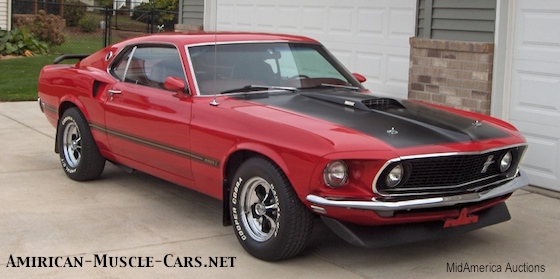
ABOVE: The 1969 Mustang Mach 1 replaced the Mustang GT option package.
THE 70s – DARK YEARS FOR THE FORD MUSTANG
Like most cars of the era, the 70s weren’t kind to the Mustang. The Mustang having grown steadily since its birth was by 1971 heavy and bloated, and with the sudden advent of smog laws and safety standards, the engines were being drastically detuned. Suddenly the bigger, better Mustang was an overweight slug. At this same time, the Muscle Car Era was dying off, as was being replaced by the age of the personal luxury car (ie: Monte Carlo, Grand Prix, Thunderbird, etc.). The first gas crunch hit in the early-70s and for the first time Americans were thinking about fuel economy. Ford made the radical decision to drastically downsize the Mustang. In 1974, the Mustang II wheezed and sputtered onto the scene now built as it was on the Ford Pinto platform and sharing the same 4 cylinder engines, then later a V6 and even a V8! But nothing helped. For the first time ever, the Camaro outsold the Mustang. But, there was a glimmer of hope on the horizon as the 70s drew to a close.

ABOVE & BELOW: The Mustang had been growing in size and weight with each 2-year reskinning. But they really went overboard with the 1971-1973 (a 4-model year cycle). Not-so-affectionately known as “fat-body Mustangs”, these bloated pigs ushered in the age of the smog-dog.
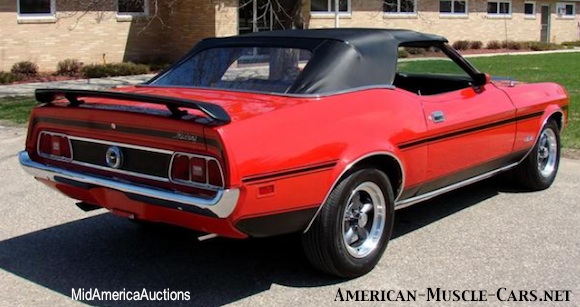
THE MUSTANG GETS BLOATED
Two more years and it was time for another restyling of the Mustang. This 1971 Mustang Mach I (top), and the 1973 Mustang Convertible (above) show how it came out. They were fat, heavy & not very handsome. The back window in the fastbacks laid so horizontal you couldn’t see out of it. They were slow too. The first American Muscle Car Era was over. To add insult to injury, after enduring 3 years with these bloated, underpowered ‘fat-body Mustangs’, what came next was even worse: The Mustang II (the second-generation). It was based on the Ford Pinto, most having only a 4 cylinder engine. It lasted until 1978 when it was replaced by the Fox Body 1979 Mustang (now the third-generation Mustang), ushering in a whole new era of classic Mustang performance.

ABOVE: Just when Mustang fans thought things couldn’t get any worse, Ford announced that the new 1974 Mustang would be based on the Pinto platform. The new Mustang II was of course, much smaller and lighter, and now powered predominately by the lowly Pinto 4 cylinder engine lineup. However, this Cobra version was launched in 1976 with an anemic 302 V8 in it. The world yawned.
FORD MUSTANG DOWNSIZES INTO THE MUSTANG II
Fears of fuel shortages and the continuing castration of engine performance due to mounting emissions requirements, Ford decided to down-size the Mustang…BIG-TIME! From 1974 through 1978 it would be called “Mustang II” and would be built on the lowly Ford Pinto chassis. They came with 4-cylinder engines, although they later became available with a 302 V8, as with the red ’78 Mustang II Ghia, pictured above. The 70s were the Dark Years for the Mustang, and for Detroit Iron as a whole.

ABOVE: 1992 Mustang GT hatchback. By this time, the “5.0” was the standard modern muscle car. It only had about 225 hp, but heck, that’s all anyone had!
FOX BODY FORD MUSTANG
In 1979 Ford introduced the 3-generation Mustang, known as the Fox-Body Mustang because it shared the Fox platform with the Ford Fairmont. It fostered the rebirth of the Mustang as a genuine performance car with hot GT 5.0s, turbocharged SVOs and even honest-to-goodness-Cobras (not standard cars with garish stripe kits, as with the Mustang II). The Fox body Mustang proved to be resilient, staying in production through the 1993 model year, a 15-year run, unheard of in the auto biz.
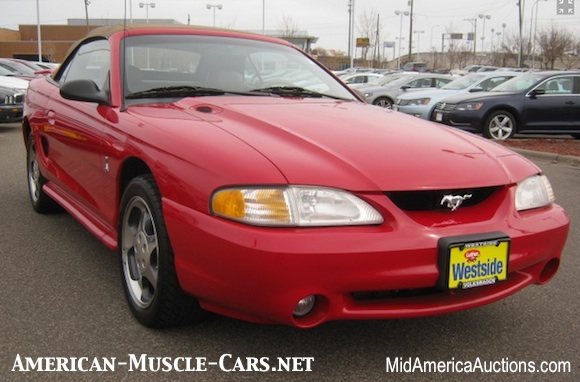
ABOVE: 1996 Mustang convertible.
4th-GEN FORD MUSTANG
In 1994 Ford released the first all-new Mustang in 15 years. Well, it wasn’t totally new, as parts of the chassis were based on the old Fox platform architecture. But nearly everything that wasn’t new was changed in some way. The new body was round, soft, but handsome and somehow still very ‘Mustang’. About the only thing that carried over were the V8 powertrains, namely the venerable 5.0 OHV V8 with either a 5-speed manual or an AOD automatic. But the 4 cylinder that had done duty in so many 3rd-gen Mustangs was gone, replaced by a 4.0 liter V6. The new Romeo family of modular OHC V8 engines arrived in 1996, now with 4.6 liters. The same block with DOHC 32-valve heads created the Cobra engine. The body was changed again, taking on a more angular, aggressive look in 1999. The power continued to grow as the Cobra engine swelled from 4.6 liters to 5.4 liters and gained a supercharger.
5th-GEN FORD MUSTANG LOOKS LIKE THE CLASSICS
Retro was back. VW hit a homer with the New Beetle. BMW brought back the Mini. Ford tried retro with its new 2-seat T-bird, but the market for 2-seaters as always was too small to make a good business case and it never sold well. But that wouldn’t be a problem with the Mustang. Everybody loves Mustangs, right? So, they restyled it completely, closely following the lines of the 1967–1968 Mustang Fastbacks, while keeping it real with modern day considerations. And they did it right, just right. the 2005 Ford Mustang was an instant classic, and an instant hit. It sold well and gained popularity and renewed interest in the classic Mustangs of the 60s. The body was reskinned in 2009 giving it a more exaggerated look, not to my personal liking. But the horsepower, made possible through prodigious supercharging is nothing short of earth-shattering.
6th-GEN FORD MUSTANG ALMOST HERE
As I write this, pictures of the next-generation 2015 Ford Mustang have been circulating in the car magazines for a month now. The photos look great. It follows the basic shape of the 4th-gen car, but with a more modern, European look to it, no doubt done to please international markets. We’ll see how it looks in the flesh. But it will probably be gorgeous. I can’t wait.
ABOVE: The new 2019 Ford Mustang Bullitt on a turntable at a pre-launch preview at Barrett-Jackson in Scottsdale 2018. Paying homage to (and cashing in on) what was perhaps the greatest car chase ever filmed, in the Steve McQueen movie “Bullitt”, it’s a street-brawler, and Ford did it right.
BRAND-NEW 2016 FORD MUSTANG!!
The 6th-generation of this iconic pony car is a huge leap ahead of the current car. It’s moved upmarket, with top-notch interior, sophisticated lines, high-tech engines and trannies, and, heaven forbid, even a fully independent rear suspension. The total package has turned out so well that, for the first time, the Ford Mustang is now truly a world car, with strong demand in the rest of the world. Congrats to Ford.
From the “WEIRD MUSTANG TRIVIA”-DEPARTMENT:
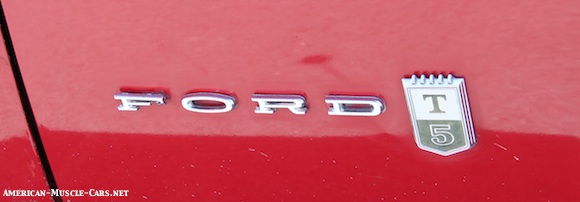
WHEN IS A MUSTANG NOT A MUSTANG?
When the Ford Mustang was introduced in ’65 in Germany, it was found that someone there already had a trademark on the product name “Mustang”, so Ford couldn’t use it there. Every Mustang that was to be sold in Germany had to have its name changed. They decided on the very European-sounding “T5”. They’re rare here stateside. What few there are usually came back with US servicemen who had been stationed in Germany. Other than the emblems, they were mechanically identical to the normal Mustang.
Ford Mustang YEAR-BY-YEAR
The birth of a legend! First year for the iconic Mustang. It’s light, its cheap & it’s fast (with V8), & can be ordered in infinite combinations: 4 engines, 3 trannies, 3 body styles & tons of options. It’s an instant hit, and it literally changes the world!
Ford said, “Don’t fix it if it ain’t broke”. The 1966 carries over largely unchanged with some minor trim differences. Same three 289 V8s, 200hp, 225hp & 271hp Hi-Po.
Wearing a new skin, the Mustang soldiers on against new competition from GM. It’s bigger, wider and more luxurious. And there is now a big block option: the 390.
Mostly carryover from last year with minor trim differences. Big block 390 is joined by the 427 side-oiler, then the 428 Cobra Jet. California Special is born.
Another body change to perhaps the best-looking Mustang ever (my opinion). Lots of great new engines & packages: Mach 1, 428CJ, 428SCJ, Boss 302, Boss 429…wow!
Mostly carryover from ’69. A new look up front with 2 headlights instead of 4, no side vents on the Fastback, etc. 390 V8 is gone. 351 Cleveland arrives. Boss302, Boss429 & 428CJ continue.
Born to do battle with the Camaro Z28, Pontiac Trans Am & the Mopar Twins, the Boss 302 had a unique engine & all the best parts throughout. Perhaps the best classic Mustang every built.
First year for the “Big-Body Mustangs”. Weight is up, power is down. But, you could still order some mega-power. This one has a 351 Cleveland.
The “Big-Body Mustangs” were bloated & the styling was almost cartoonish. The back window was so sloped in the fastback that you could barely see out. But, the Mach 1s were very cool.
Last of the “Big-Body Mustangs”. Power was down, weight was up…and the Mustang II was coming!
1976 MUSTANG COBRA II
V8 power in the Pinto-based Mustang II. Even with gutless 70s smog-dogs, that’s got to be a winning combo. Slowly becoming collectable today.
The oil shortage prompted Ford to downsize the Mustang. Now built on the Ford Pinto platform, it came standard with a 4 cylinder, but later a 302 V8 became available.
Limited-production 1984-86 SVOs had a 2.3L 4-cyl turbo with the same power as the 5.0 V8, but much less weight. Faster & better handling than the GT.
1985 MUSTANG CHP CAR
Ford made around 15,000 of these “SSP” models for the CHP & other Police, from 1982-1993.
1985 MUSTANG GT
It took until ’85 for the Mustang to start getting its mojo back.
1986 MUSTANG GT CONVERTIBLE
1986 is the last year for 4-barrel carburetors, but you had to get the 5-speed to get it. Autos got the throttle-body EFI (slow).
1988 MUSTANG CHP CAR
The California Highway Patrol used this little Fox-body to chase the bad guys…and good guys who were just speeding.
Steve Saleen worked his magic on the Fox-body Mustang (79-93). More power, better handling, unique looks.
First year of the 4th-generation brought a rounder, more aero look to the Mustang. Pix of a ’94 Mustang Cobra Convertible Pace Car.
1996 Saleen Mustang S351
Steve Saleen specializes in building wickedly-fast Mustangs. This is a ’96 S351 Convertible w/eye-popping pictures, specs, history & more…
Built by Ford’s SVT ‘Skunk Works’, the Cobra was the hottest car the Blue Oval had to offer in the 90s.
1999 MUSTANG SVT COBRA
The boys at Ford’s SVT Skunk Works cooked up a wicked DOHC 32-valve version of the 4.6L V8 for the Cobra.

2003 MUSTANG MACH 1
The Mach 1 got a 300-horsepower 4.6-liter DOHC 32-valve V8.
1st year for the 5th-gen Mustang w/new Retro styling. This one happens to be my personal driver. Fully-loaded Premium model with 5 speed, leather, big stereo, the works!
“My First Autocross” – Ride along as we take this ’05 GT out on the Autocross Track.
The Mustang went totally retro in 2005, with great looks harking back to the ’67-’68 Mustangs.
The Boss is back. And it’s bigger, badder and faster than ever!! 5.0 Liter DOHC V8 power + modern handling & brakes.
The Boss 302 continued on a limited-production basis. High-performance 5.0 liter DOHC V8 power, new stripes (like the old ‘hockey sticks’.
Big power from the 5.0 Coyote V8, handling upgrades & much more.
Exclusive pre-release sneak peak, and we were there. Eye-popping photos of the brand-new, stunning 6th-gen Mustang! Don’t miss it!!
This GT Limited Edition sports a 5.0 DOHC Coyote V8 & all the best performance goodies.
2017 Mustang GT
The 6th-gen Mustang gets even hotter. The 5.0 Coyote V8 makes 435hp.
Honoring the Steve McQueen movie “Bullitt”, this modern-day street brawler was caught on a turntable at Barrett-Jackson. Get a sneak peak before its released to the world.
Carroll Shelby’s “Doctor Frankenstein” laboratory at LAX turned out one raucous muscle car after another, with Ford power & lots of it.
Carroll Shelby’s original souped-up Mustang with 350hp Hi-Po 289, beefed-up suspension & brakes & heavy duty everything.
The last year that was actually built by Carroll Shelby. Starting in ’68 Ford built them on the production line alongside civilian Mustangs.
The last year that was actually built by Carroll Shelby. The GT500 swapped the GT350’s small block out for a 428 Cobra Jet big block V8.
The monstrous 428 CobraJet big block under the elongated hood earned the GT500KR the nickname “King of the Hill”.
The last Shelby GT350 came with a 351 V8. Shelby walked away in ’69, so none were built in 1970. All 1970 Shelbys were built in ’69 & reissued as 1970 models.
2008 Shelby Mustang GT500 Super Snake
A Shelby in name only, Ford stuffed in a 540hp supercharged 5.4L V8 and let ‘er rip!!!
FORD ENGINES
From the Flathead to the new Voodoo, pictures, specs, history & more on Ford’s many V8 engine families.



